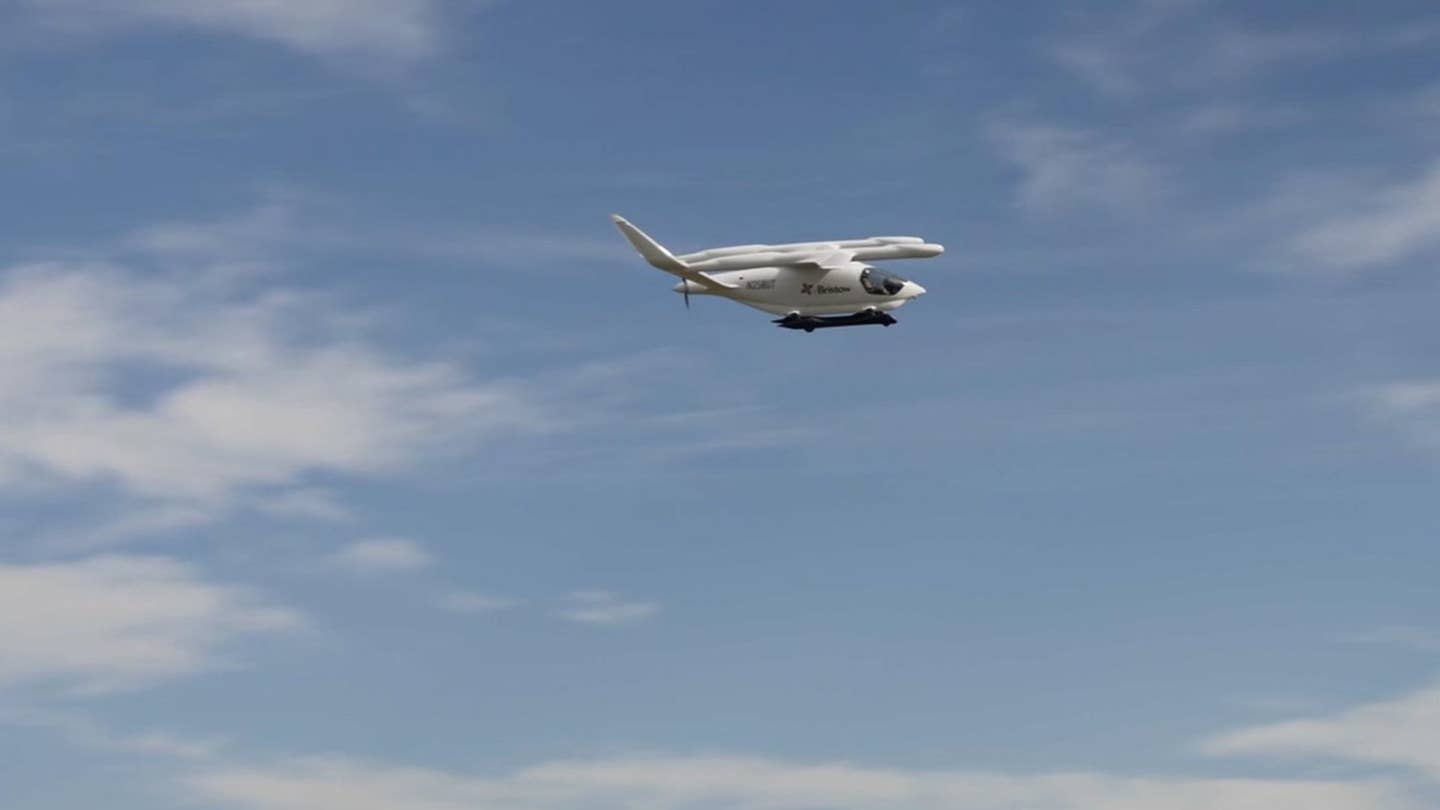Beta Technologies, Bristow Group Bring First Electric Aircraft to Louisiana
Electric aircraft manufacturer Beta hopes to take its conventional takeoff and landing (CTOL) Alia to market in 2025.

Beta Technologies’ electric Alia conventional takeoff and landing (CTOL) design performs a flyover at Bristow Group’s Houma, Louisiana facility. [Courtesy: Beta Technologies]
An electric aircraft has flown in the state of Louisiana for the first time, according to partners Beta Technologies and Bristow Group.
The manufacturer and vertical flight provider on Wednesday hosted more than 100 spectators for a demonstration of Beta’s electric Alia conventional takeoff and landing (CTOL) aircraft—which the company intends to launch commercially in 2025—in Houma, Louisiana, about 50 miles southwest of New Orleans. The companies claim the aircraft is the first of its kind to arrive in the state.
Beta also asserts that the Alia CTOL is the first electric aircraft to be flown by the U.S. Air Force, Army, FAA, and now Bristow pilots. Bristow placed a firm order for five vertical takeoff and landing (VTOL) Aria variants, with an option for 50 more, in August 2022. When Beta announced plans for the CTOL model, the operator placed an additional deposit-backed order for 50 conventional aircraft.
“We designed Alia with the goal of carrying out the most critical missions in a safer, cleaner, and more efficient manner,” said Kyle Clark, founder and CEO of Beta. “We’re excited to fly Alia into Bristow’s home base in Louisiana, marking the first time an electric aircraft has flown in the state and the next step of our partnership together as we look to execute real missions in the market.”
In addition, Bristow has placed orders for 50 electric short takeoff and landing (eSTOL) aircraft from Electra.aero, as many as 80 Volocopter VoloCity eVTOLs, and up to 100 Elroy Air Chaparral VTOL cargo drones.
Bristow primarily provides services to offshore energy companies and government entities, conducting missions such as personnel transport and search and rescue. Now, the company is looking to introduce electric, zero-emission aviation to its markets worldwide, complementing its catalog of vertical flight offerings with advanced air mobility (AAM) services.
The nearby Gulf of Mexico is one of the firm’s largest service regions, but it also has customers in 17 countries.
“Our vision is to be an innovator in flight solutions,” said Dave Stepanek, executive vice president and chief transformation officer at Bristow. “We believe aircraft like Beta’s Alia can expand our offerings and complement some of our current services. Our thinking is our current customers are natural AAM customers initially. We believe it will open up many new possibilities in the Gulf region.”
Among the more than 100 attendees at Beta and Bristow’s demonstration in Houma were local politicians, airport officials, customers, and subject matter experts. Spectators watched the CTOL make several passes over the airfield to exhibit its maneuverability.
“These new technologies have the potential to make certain missions more efficient, quieter, more accessible, and more sustainable,” said Chris Bradshaw, president and CEO of Bristow. “We view AAM as a natural extension of Bristow’s core competencies of safe and reliable vertical flight solutions, and we see multiple avenues for Bristow to participate in the emerging AAM value chain.”
Added Clark: “Bristow has built a strong reputation doing this across the globe, and continues to lean forward to what’s next. The team has been a crucial partner to Beta over the years, providing input and support every step of the way from design to mission application to aircraft handling feedback.”
The CTOL’s visit to Bristow—one of its first stops on the way back to Beta’s Burlington, Vermont, headquarters—follows the conclusion of Beta’s first electric aircraft deployment for the Air Force at Eglin Air Force Base’s Duke Field (KEGI) in Florida. There, the aircraft flew simulated missions including the first simulated casualty evacuation with an electric aircraft.
Beta said Alia, en route to Duke, became the first electric aircraft to fly in the flight restricted zone of Washington, D.C., stopping at nodes in Beta’s expanding electric charging network along the way. That network includes a charging station at Duke, which was the first electric aircraft charger to be installed at a Department of Defense site. According to the company, nearly 20 locations are now online, with a further 50 in development.
Beta’s charging network will support AAM operations nationwide when the time comes, opening up as many airfields as possible for Alia, as well as all electric aircraft and ground vehicles, the company says. The firm hopes to introduce the CTOL in 2025, followed by the VTOL variant in 2026.
Like this story? We think you'll also like the Future of FLYING newsletter sent every Thursday afternoon. Sign up now.

Subscribe to Our Newsletter
Get the latest FLYING stories delivered directly to your inbox






